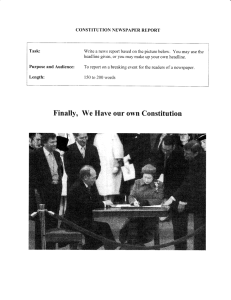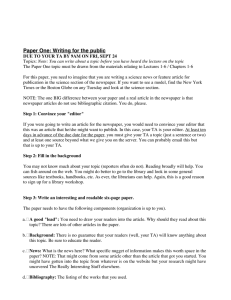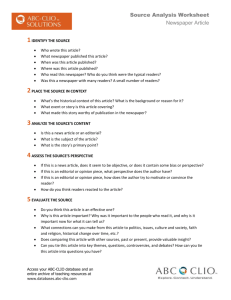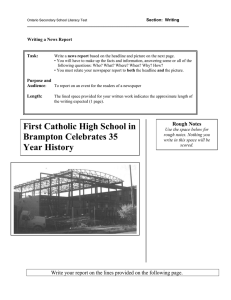Handout here
advertisement
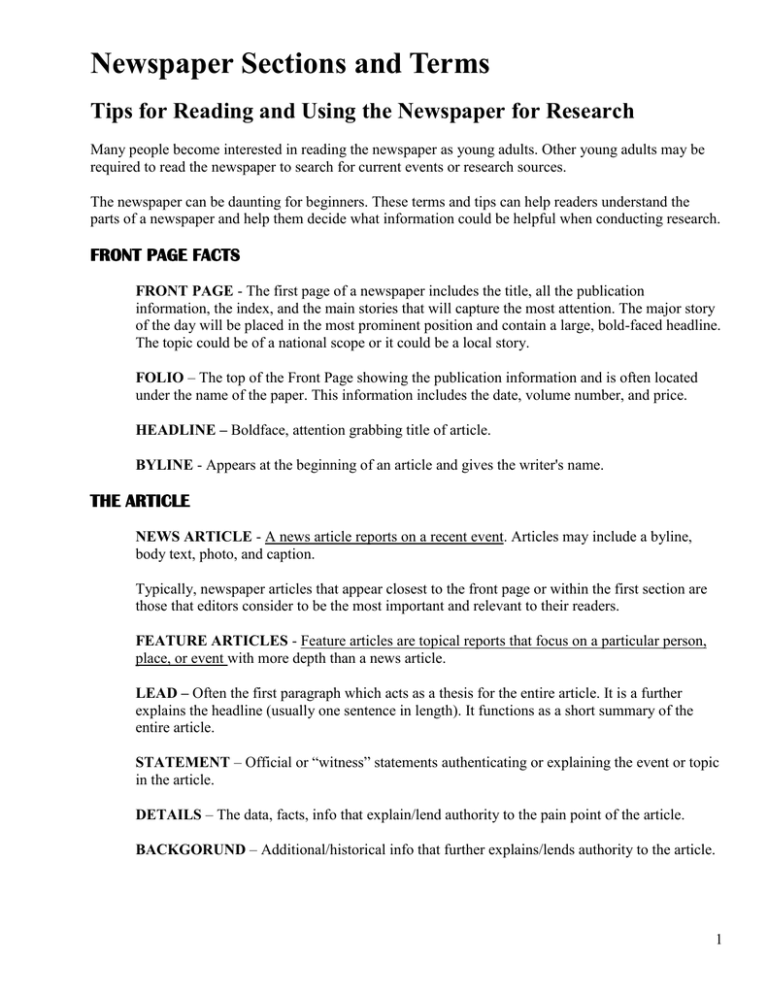
Newspaper Sections and Terms Tips for Reading and Using the Newspaper for Research Many people become interested in reading the newspaper as young adults. Other young adults may be required to read the newspaper to search for current events or research sources. The newspaper can be daunting for beginners. These terms and tips can help readers understand the parts of a newspaper and help them decide what information could be helpful when conducting research. FRONT PAGE FACTS FRONT PAGE - The first page of a newspaper includes the title, all the publication information, the index, and the main stories that will capture the most attention. The major story of the day will be placed in the most prominent position and contain a large, bold-faced headline. The topic could be of a national scope or it could be a local story. FOLIO – The top of the Front Page showing the publication information and is often located under the name of the paper. This information includes the date, volume number, and price. HEADLINE – Boldface, attention grabbing title of article. BYLINE - Appears at the beginning of an article and gives the writer's name. THE ARTICLE NEWS ARTICLE - A news article reports on a recent event. Articles may include a byline, body text, photo, and caption. Typically, newspaper articles that appear closest to the front page or within the first section are those that editors consider to be the most important and relevant to their readers. FEATURE ARTICLES - Feature articles are topical reports that focus on a particular person, place, or event with more depth than a news article. LEAD – Often the first paragraph which acts as a thesis for the entire article. It is a further explains the headline (usually one sentence in length). It functions as a short summary of the entire article. STATEMENT – Official or “witness” statements authenticating or explaining the event or topic in the article. DETAILS – The data, facts, info that explain/lend authority to the pain point of the article. BACKGORUND – Additional/historical info that further explains/lends authority to the article. 1 OTHER SECTIONS OF THE “PAPER” EDITORIALS / OP-ED SECTION - An editorial is an article written by the editorial staff from a specific perspective. The editorial will offer the newspaper's view of an issue. Editorials should not be used as a main source of a research paper, because they are not objective reports. EDITORIAL CARTOONS - Editorial cartoons have a long and fascinating history. They offer an opinion and convey a message about an important issue in an amusing, entertaining, or poignant visual depiction. LETTERS TO THE EDITOR - These are letters sent from readers to a newspaper, usually in response to an article. They often include strong opinions about something the newspaper has published. Letters to the editor should not be used as objective sources for a research paper, but they could prove valuable as quotes to demonstrate a point of view. INTERNATIONAL NEWS - This section contains news about other countries. It may address relationships between two or more countries, political news, information about wars, droughts, disasters, or other events that impact the world in some way. ADVERTISEMENTS - Obviously, an advertisement is a section that is purchased and designed for selling a product or idea. Some advertisements are obvious, but some can be mistaken for articles. All advertisements should be labeled, although that label might appear in small print. BUSINESS SECTION - This section contains business profiles and news reports about the state of commerce. You can often find reports about new inventions, innovation, and advances in technology. Stock reports appear in the business section. This section could be a good resource for a research assignment. It will include statistics and profiles of people who have made an impact on the economy. ENTERTAINMENT OR LIFESTYLE SECTION - The section names and traits will differ from paper to paper, but lifestyle sections typically offer interviews of popular people, interesting people, and people who make a difference in their communities. Other information concerns health, beauty, religion, hobbies, books, and authors. BEHIND THE SCENES OWNER – EDITOR - An editor decides what news will be included in each paper and determines where it will appear according to relevance or popularity. The editorial staff determines content policy and creates a collective voice or view. 2
